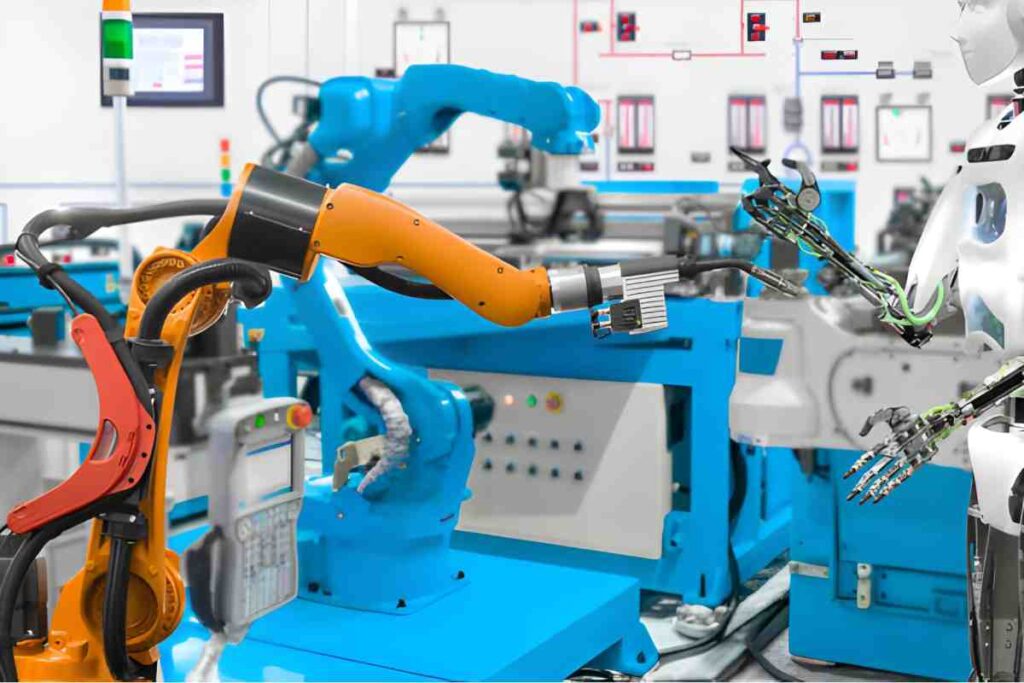Today, sustainability has evolved from a secondary concern to a fundamental principle of modern manufacturing, and Environmental regulations. Resource depletion, and consumer awareness of eco-friendly products have prompted manufacturers to seek new ways to reduce their conservational impact without sacrificing efficiency and profitability. The meeting of artificial intelligence (AI) and the Internet of Things (IoT) represents an unprecedented paradigm shift that could lead to exponential growth in sustainability throughout the entire production lifecycle, moving from data-driven decision-making to automation.
I. IoT’s Role in Sustainable Manufacturing
As the foundation of sustainable manufacturing, the Internet of Things (IoT) uses networked sensors and software to collect real-time data from various processes. This integrated connectivity provides high transparency and control over resource consumption, waste, and operational efficiency.
1. Better Waste Management
IoT sensors can be strategically placed, from monitoring material flow on production lines to identifying material usage and waste streams in real time for tracking. Using the data collected by these sensors, manufacturers can determine where, how much, and what types of products are being lost, and develop strategies for reduction, reuse, or recycling (quantification). Smart containers with sensors are more efficient, so scheduled waste collection reduces fuel consumption and emissions from waste transportation.
2. Improved Emission Monitoring
Industrial processes often generate associated emissions that can impact air or water quality. IoT sensors can monitor emissions at manufacturing facilities in real time (thanks to IoT-enabled sensors). Access to continuous emissions data allows manufacturers to identify deviations, confirm compliance with environmental regulations, and optimize their processes for greater sustainability. Timely detection of excess emissions, allowing for corrective action, prevents environmental damage and regulatory fines.
3. Total Supply Chain and Fleet Management
Sustainability extends beyond production facilities and encompasses the entire supply chain and logistics. Any IoT device, such as GPS trackers or environmental sensors, can provide a complete picture of product movement, transportation, and fleet operations. This data can be used to improve transport routes, minimize fuel consumption and emissions by monitoring livestock’s temperature and moisture content to prevent damage and contamination, and, among other things, ensure transparency regarding the sourcing of raw materials made from unsustainable materials.
4. Developing High-End Products
Manufacturing equipment with embedded IoT sensors can measure critical restrictions such as temperature, pressure, vibration, and speed. By continuously monitoring these factors, manufacturers can ensure product compliance and reduce defects, rework, and waste associated with substandard products. This focus on quality during production allows for material savings, lower energy consumption related to subsequent processing, and minimizes the environmental impact of wasted products.
5. Maximizing Downtime
Energy loss from idle machines (which consume tons of fuel per hour due to downtime) occurs during unscheduled downtime. IoT sensors monitor equipment condition 24/7, collecting data for early fault detection. This facilitates predictive maintenance to prevent failures, reducing machine downtime and inefficient operation, thereby preventing energy loss. IoT data is critical for computerized maintenance management systems (CMMS), which provide the foundation for intelligently planned maintenance.
6. Asset Lifecycle Management ( ALM )
The Internet of Things (IoT) is essential for achieving any level of successful asset management (ALM) (maximizing asset value and service life while minimizing environmental impact). Continuous asset condition monitoring via IoT enables informed decisions about maintenance, repair, upgrades, and disposal. It facilitates timely and responsible asset replacement (as opposed to premature loss leading to waste), enabling informed decisions about their efficiency and service life. IoT data is integrated into a CMMS (computer-managed asset management system) to provide a complete picture of asset condition throughout their entire lifecycle.
7. Smart Automation
Intelligent industrial automation begins with IoT devices and sensors. Real-time production data allows automated systems to adjust parameters and workflows based on this data. This significantly reduces energy consumption and waste, and optimizes resource use. IoT-based automation of lighting and HVAC systems, such as occupant-based deactivation, reduces energy consumption in low-traffic areas.
II. Role of AI in Enhancing Sustainability

1. Predictive Maintenance
Data collected from IoT sensors monitors equipment health in real time; AI algorithms predict problems before they occur thanks to AI-powered predictive maintenance. This preventative method, predictive maintenance, allows manufacturers to perform maintenance only when necessary and avoid unnecessary downtime. This reduces energy costs caused by inefficient equipment, extending its service life by conserving resources. Combining AI and a maintenance management system (CMMS) enables predictive maintenance execution and planning.
2. Artificial Intelligence (AI) for Quality Control
- Reducing waste and defects: Early detection means fewer defective products, less material waste, and less energy consumed in production.
- Energy optimization: AI analyzes energy consumption trends in production processes and recommends optimization points, such as adjusting equipment parameters or launching operations during reduced-demand periods.
- Predictive maintenance using managed systems: The first method involves AI interpreting quality data from sensors, which can indicate a defect requiring intervention before it occurs, and then alerting us immediately after a decision.
- Supply chain optimization: AI algorithms can process large volumes of supply chain data, helping prevent disruptions, optimize routes, and reduce transportation emissions.
3. Eco-friendly product Design
AI can facilitate more sustainable product design by analyzing data on material properties, manufacturing processes, product lifecycle impacts, and AI-assisted end-of-life scenarios. Manufacturers can virtually test their products using AI-powered modeling and digital twin technologies. This reduces the high costs and resource burden associated with physical prototyping of low-material (lightweight) and energy-efficient products with low recyclability.
4. Work Order Management and GenAI
CMMS and artificial intelligence, particularly generative artificial intelligence (GenAI), can potentially transform the future of work order management. Work order automation powered by GenAI enables the creation of work orders based on predictive maintenance results or identified anomalies, the submission of work orders with predefined fields, the suggestion of an optimal maintenance process, and even the generation of reports and summaries. The result is a faster and more efficient maintenance process that resolves administrative issues. Prevents delays due to interventions, and promotes operational efficiency and sustainability by minimizing equipment downtime and optimizing resource allocation.
5. Inventory Management & Forecasting
AI algorithms can analyze sales history, market trends, seasonal volatility, and external factors to generate accurate and proactive demand forecasts. This allows manufacturers to accurately determine inventory levels to avoid overstocking (which creates potential losses and storage overhead costs) and shortages that disrupt production, which can lead to production bottlenecks. AI-powered inventory management reduces waste and improves resource efficiency, reducing unnecessary warehousing and transportation issues.
III. Synergies: AI and IoT Working Together
The potential of AI and the Internet of Things to improve manufacturing sustainability is enormous, and this potential is enhanced when they complement each other. As the Internet of Things accesses data, AI becomes smarter at viewing, understanding, and processing it. Here are some of the key synergies:
Real-time optimization: Using real-time cloud-based IoT sensors with integrated AI algorithms to analyze production data, enabling us to identify immediate opportunities for energy and resource savings and reduce waste.
Closed-loop control: The Internet of Things enables incorporating AI data into automated systems for closed-loop control. For example, automatic equipment configuration uses AI and IoT sensor data to analyze energy consumption data and reduce costs for heating. Lighting, and more (without humanoid interference).
Digital twins for sustainability: IoT information and AI analytics enable the creation of “digital twins”—virtual replicas of anything, from physical assets and processes to entire factories. These digital doubles can be used to run situations. Test sustainability plans, and identify potential negative impacts of various operational decisions through modeling using real data rather than guesswork.
Advanced decision support: AI algorithms can analyze large volumes of IoT data to provide manufacturers with comprehensive insights and recommendations for sustainable transformations across all areas of their operations—from optimizing production schedules to selecting more sustainable materials.
Final Thoughts:
The interaction of artificial intelligence and the Internet of Things offers a revolutionary manufacturing solution that could contribute to increased sustainability in the sector. By enhancing transparency, intelligent decision-making, and automation, these technologies provide companies with tools to reduce their environmental impact, optimize resource use, and increase efficiency. Given the growing pressure on sustainability, the strategic use of artificial intelligence and the Internet of Things is key to sustainable competitiveness. Responsibility, and resilience, as well as to driving innovation that creates a more sustainable future in manufacturing.

